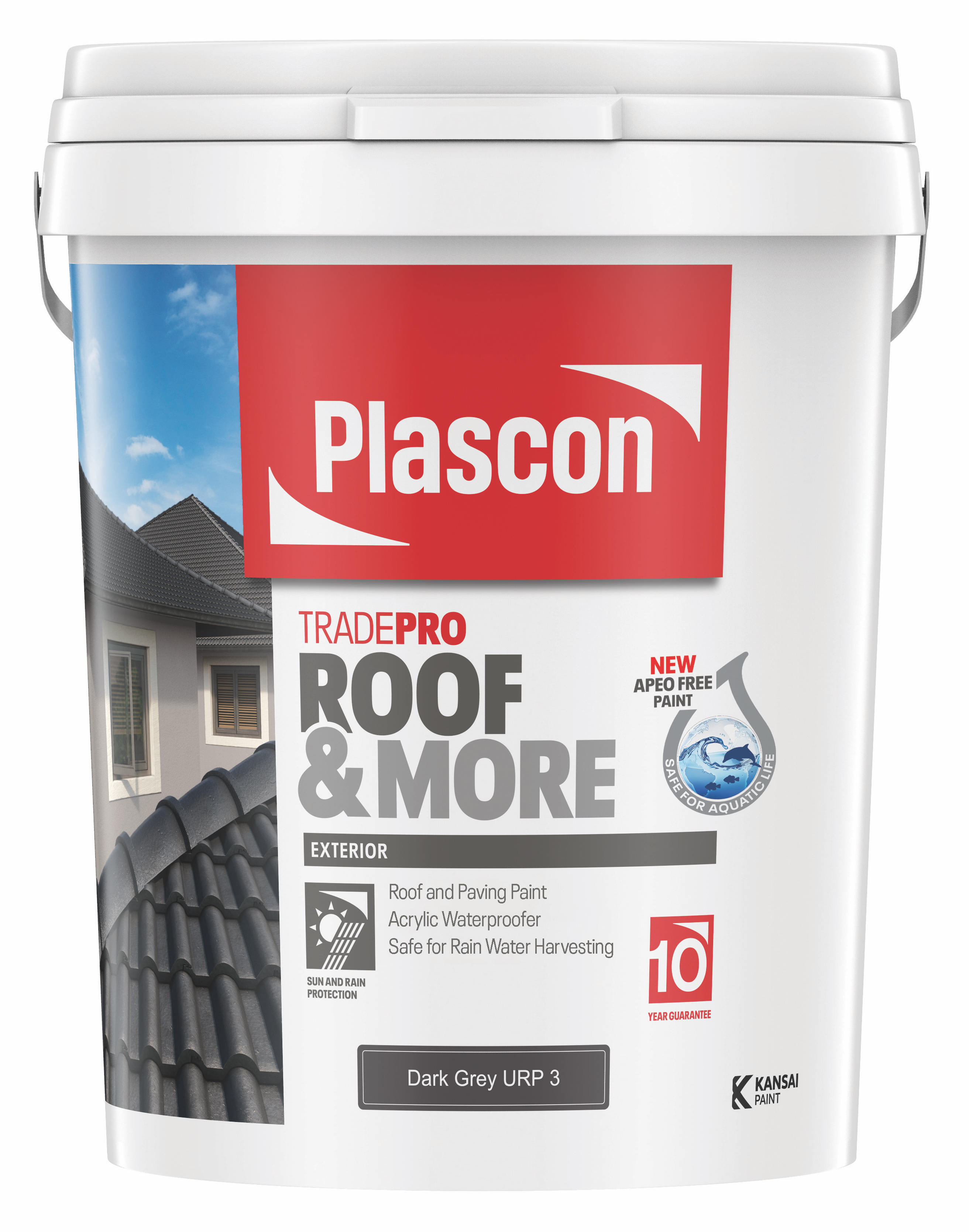All you need to know about Plascon TradePro Roof & More

It’s good for roofs, it’s good for consumers and it’s good for the environment – what more could you ask for from a roof coating? Plascon’s latest addition to its durable exterior coatings range, Plascon TradePro Roof & More, offers more benefits than ever – all in one product. What makes Plascon TradePro Roof & More even more remarkable is that it is Africa’s first roof paint to be entirely free of the harmful APEO chemical compounds. APEO compounds are persistent and bio-accumulative when released into the environment and toxic to human and wildlife, especially marine life. All other conventional roof paints contain APEO compounds that, over time, are washed into the environment and eventually contaminate the soil, water tables, rivers and ultimately, our oceans. For this reason, many European Union and other countries have banned the use of APEOs.
Frequently Asked Questions
1. What can I use Plascon TradePro Roof & More for?
To paint and waterproof various roof types (cementitious, fibre cement and galvanized roofs), and coat multiple exterior surfaces such as paving, facias, gutters, down pipes, window sills, garage doors, garden pots and cladding.
2. How is Plascon TradePro Roof & More ‘multi-functional’?
Plascon TradePro Roof & More is the world’s 1st roof paint and acrylic waterproofer with a 10-year guarantee. It is Africa’s 1st APEO-free roof paint making it safe to harvest non-potable rainwater from roof runoff, saving consumers money on their monthly municipal water bill. And it can be used on all exterior surfaces listed in question
3. What are APEO’s?
APEO’s or alkylphenol ethoxylates are common surfactants that are widely used in the manufacture of paint coatings, apparel, home textiles and in the shoe industry. They are discharged into the environment and, as APEO’s degrade very slowly, they accumulate in water resources like rivers, dams and the ocean, plants and animals. APEO’s are extremely toxic to aquatic life resulting in the depletion of freshwater and marine fish stocks.
4. Can I drink the water harvested from roofs painted in Plascon TradePro Roof & More?
No. The water is not suitable for human or animal consumption. However, as the water does not contain any APEO’s it is safe for:
- Watering gardens and filling water features
- Topping up swimming pools
- Washing all exterior areas around the home
- Washing cars and equipment
- Washing laundry and general household cleaning
- Flushing toilets
5. Is Plascon TradePro Roof & More only suitable for application on roofs?
No. See suitable substrates in response to question 1.
6. How do I prepare my roof to paint with Plascon TradePro Roof & More?
Different roofs and their conditions require different preparation methods. Visit the Plascon website – www.plascon.com – or contact our customer care line on 0860 20 40 60 for more information.
7. How many coats of Plascon TradePro Roof & More do I need to paint on my roof to get long-lasting colour and waterproof my roof?
Applications on roofs require two coats.
For waterproofing:
For all primed and sealed surfaces, apply a full coat of Plascon TradePro Roof & More, immediately embed the polyester membrane into the wet coating ensuring that the membrane is thoroughly saturated by the coating. Before this coat is completely dry apply a further coat to completely cover the membrane.
Allow to dry and finish with a final coat to completely cover the membrane then apply a finishing coat.
8. How often do I need to recoat my roof in Plascon TradePro Roof & More to ensure that it remains waterproof?
A maintenance coat is required every 5 years on the waterproofed area to keep your roof leak-free.
9. Is a roof painted with Plascon TradePro Roof & More easy to keep clean?
Rain or spraying the roof with water should wash off any dust from the roof.
Roof Maintenance Tips:
Roofs are exposed to sunlight, rain, hail, wind and temperature changes that gradually degrade roofs.
- Maintenance prevents premature leaks and aging and identifies minor problems before they become major costly problems.
- Roofs should ideally be inspected annually at the end of the dry season.
- Roofs should also be inspected after any storm with high winds, extreme rain or hail, or if construction has taken place on the roof area.
- Roof maintenance should include:
4.1. Replacement of broken, loose, missing or worn tiles that may result in leaks.
4.2. Inspection of previously repaired areas.
4.3. Removal of leaf and debris build-up from roof valleys.
4.4. Cleaning of gutters and downpipes to prevent corrosion, blockage and water pooling.
4.5. Repair flashings at areas such as skylights, perimeter walls and drains.
4.6. Eliminate water pooling that may result in damage to ceilings and electrical wiring.
Water Harvesting Tips:
Water harvesting saves water and money, but please heed the following guidelines:
- Secure the water storage tank and prevent internal access to children and pets.
- Position the tank on the side of the home that receives the most shade.
- Ensure easy access to the pump, inlet and outlet ports.
- Regularly clean mosquito screens and filters.
- Remove debris and flush tank to remove sediment.
- Clean gutters often and fit them with leaf guards or protectors.
- Harvested rainwater is for non-potable use only. Non-potable water is safe for:
7.1. Watering gardens and filling water features.
7.2. Topping up swimming pools.
7.2. Washing all exterior areas around the home.
7.3. Washing cars and equipment.
7.4. Washing laundry and general household cleaning.
7.5. Flushing toilets.
For more information visit www.plascon.com.






